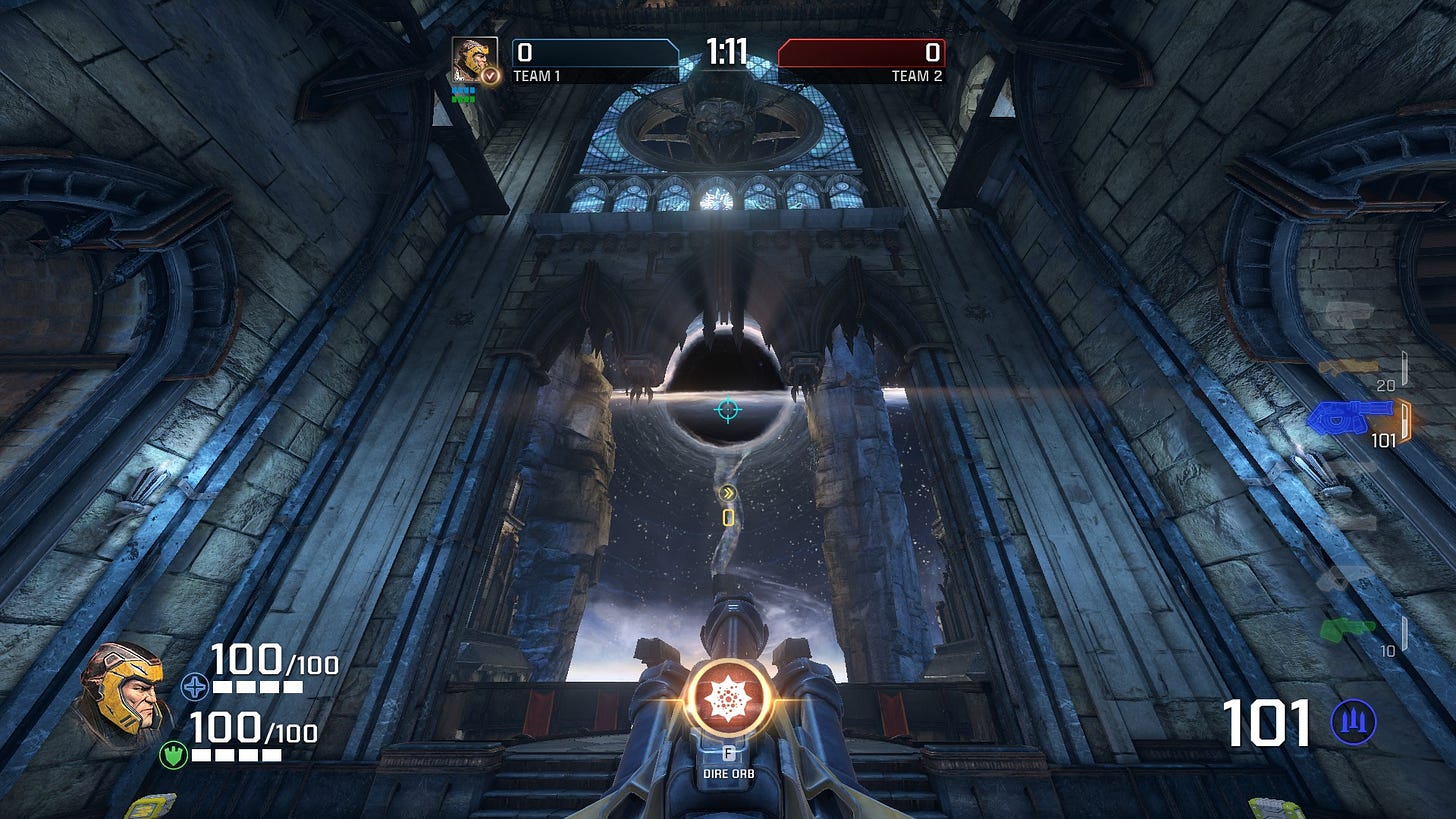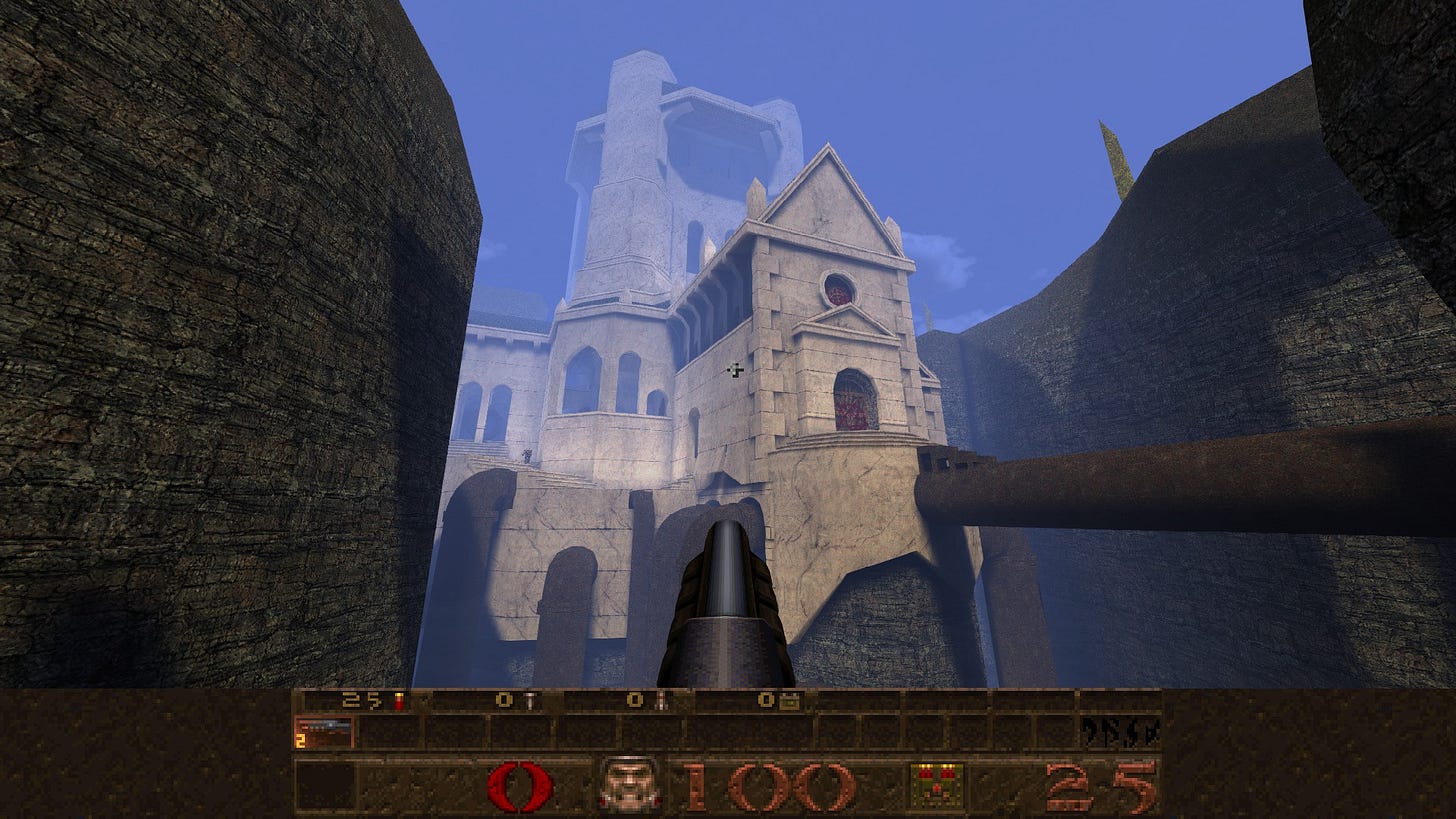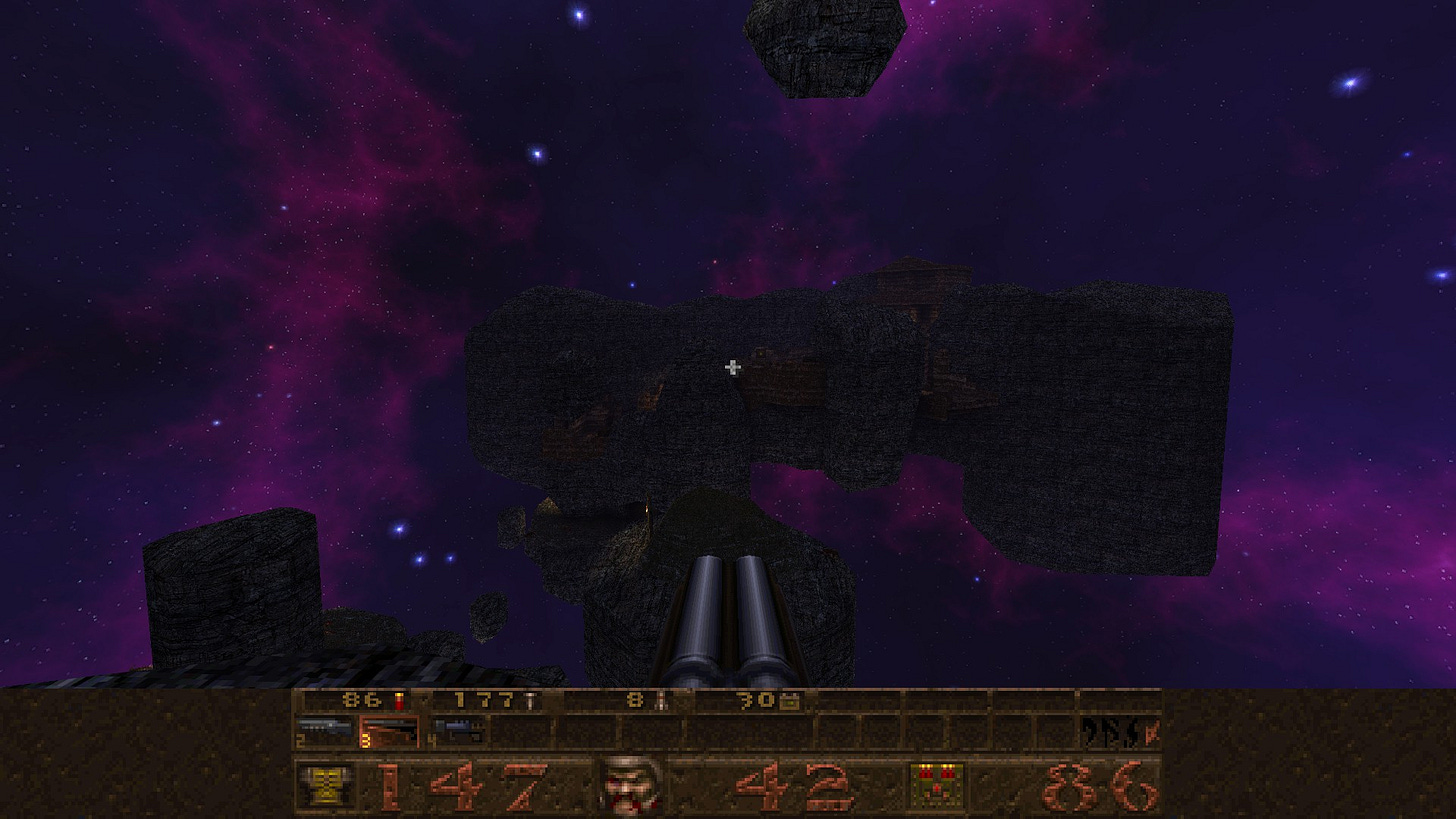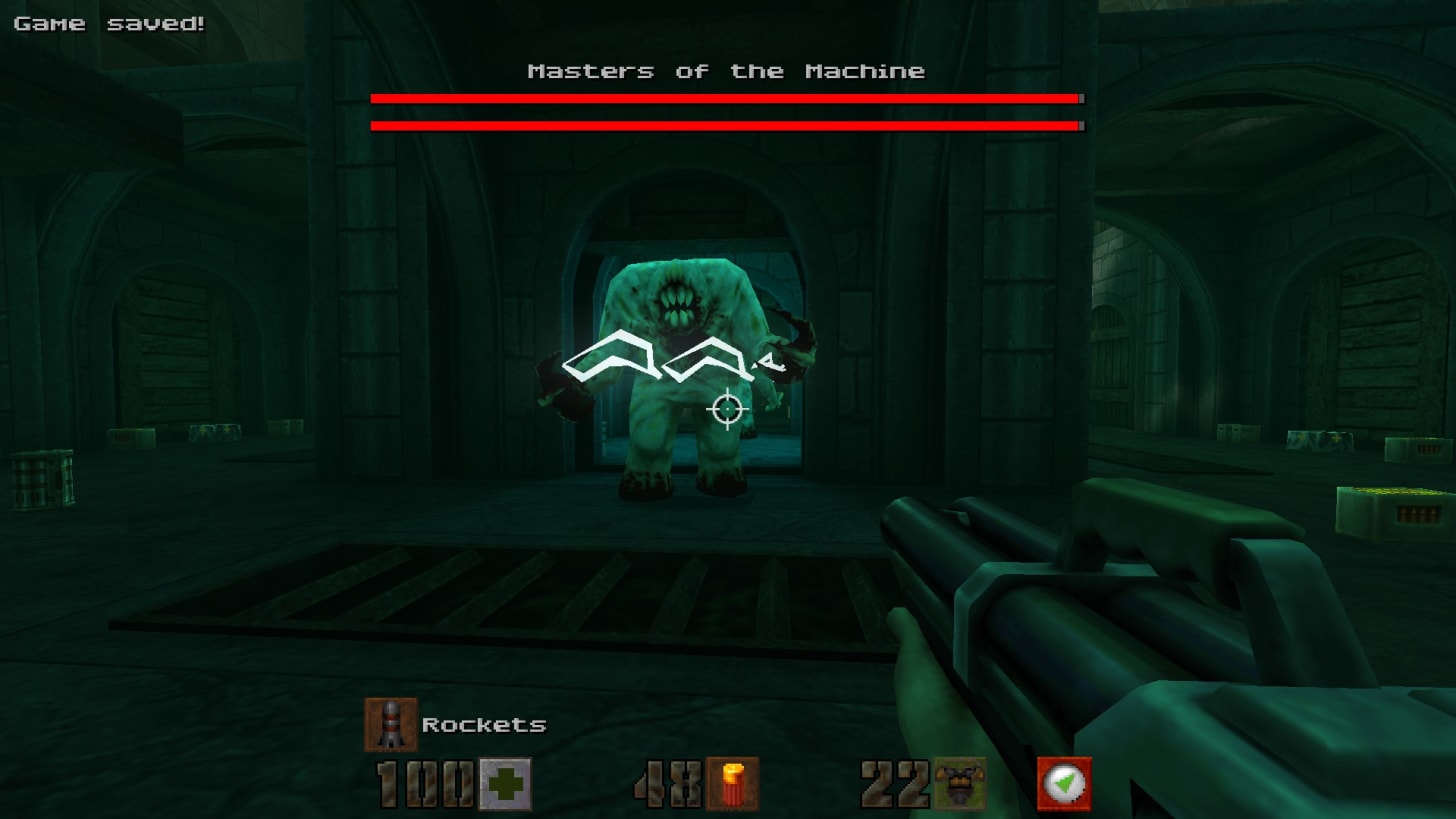Final Episode: Dimension of the Future
Where Quake Stands Today, and Where it Could Be Tomorrow
Welcome to the final episode of “Quake’s Bizarre, Beautiful History!” Read the previous episodes here:
The last attempt at a new Quake title, Quake Champions, wasn’t the triumphant return anyone wanted it to be. With staggeringly low worldwide player counts, any other company would have probably shut the servers down for a game like Champions a long time ago, but id and their Bethesda overlords haven’t. Hell, it was only last year that the officially sponsored Quake Pro League finally came to an end, and a small but dedicated team continues to update the game every few months. Why is that? It probably isn’t because the game’s still profitable, and they certainly don’t seem to be planning any major game-reviving updates. I think the answer is a simple one, so simple that you probably don’t expect it from a big company owned by Microsoft, of all people. It’s the answer I’ve been arguing for all this time with my article series.
Quake just deserves to live. So many people working at id, MachineGames, or other Bethesda subsidiaries got their starts making Quake maps. Hardly anything in the multiplayer FPS market can match its unique sense of speed and strategy. Even as the new Doom titles and indie titles like Dusk and Amid Evil derive so much from it, there still isn’t anything that does Quake quite like Quake at its best. Some might look at Quake’s long history up to now and view it as a tragedy. At the end of this long road, I’m instead going to highlight everything that makes this wonderfully strange franchise feel so alive even today, from inside the studios behind it and out.
Ageless, Undying
Ever since the original Quake’s release, fans have been getting better and better at designing their own maps for the game. Some have pushed the game’s original engine limits and assets to their limits, while others use enhanced source ports - external fan-made programs which interpret the game’s source code in ways that allow for things like better performance on modern hardware or new design elements the original engine wouldn’t have allowed for - to create maps that push the limits of what Quake was. Like classic Doom, Quake’s accessible-by-design mapping tools have made it into an essential stepping stone for many developers and given it one of the most passionate modding communities out there. It might not seem like good business to make it so easy for fans to freely make and distribute content for your own game, but the guys at id in 1996 knew that such goodwill pays off.
One professional game dev with a history in Quake is Jerk Gustaffson, co-founder and creative director of the predictably Sweden-based MachineGames. As already indicated in my review of Indiana Jones and the Great Circle, I have nothing but respect for MachineGames and their ever-growing catalogue of games that let me realize my dreams of brutalizing fascists. Gustaffson is a big reason that the new Wolfenstein titles and Great Circle are as fun as they are, and it’s probably because he never forgot his roots. In 2016, he designed a brand-new episode for Quake called Dimension of the Past, released for free by MachineGames to commemorate the game’s 20th anniversary. It’s not one of those fancy limit-breaking mapsets with new enemies or guns, but it is an extremely solid set of maps that goes to show just how much Quake’s biggest fans have come to understand its enemies, weapons, and movement.
It turns out that, when old games inspire the next generation of developers, many of them like to give back. This seems the guiding principle behind Nightdive Studios, a company dedicated to picking up old pc games, dusting them off, and making them easier and better to play than ever on every platform. After five years of resurrecting classics like System Shock, Turok, and Blood, they first worked with id software on bringing Doom 64 off the N64 for the first time. A year after this, they’re back to work their magic on none other than Quake for its 25th birthday. When Nightdive brings an old PC game back, they don’t just make sure it works on modern Windows iterations and call it a day. Quake Remastered features comprehensive visual enhancements, new gameplay and accessibility settings, and every expansion pack from Dissolution of Eternity to Dimension of the Past. Single-player and multiplayer are fully implemented, and there’s even a new co-op horde mode with its own original maps. On top of this, it includes the slightly-tweaked N64 port of Quake and brings everything the game has to offer not just to modern PCs, but to every modern console. There’s never been a better way to Quake, and existing Quake owners on Steam got the full remaster for free!
Oh, but we STILL aren’t done. With Gustaffson being far from MachineGames’ only Quake veteran - their level design team also includes Christian “czg” Grawert, one of the biggest names of Quake’s early modding scene - the rest of the company decided to get in on the action for the 25th anniversary, too. In comes Dimension of the Machine, a new expansion exclusive to the remaster which dials Quake up to 11. Taking place across five mini-episodes of two maps (three in the Realm of Machinists because of the secret map), each realm brings Quake’s classic, mysterious atmosphere to new and creative settings. Ranging from infernal machines to ancient temples hidden deep in space, this excellent expansion shows just how much creative potential still lies within Quake even without any new enemies or weapons. The brutal, but cool final boss battle sees Chthon - the first episode’s pushover boss - getting his revenge. Now outside of an arena with lightning traps specifically designed to kill him, you have to contest with his deadly fireballs and waves of strong enemies to scrounge up enough lightning gun ammo to fry him yourself. If that’s not enough, Quake Remastered even hosts a few popular fan mapsets which the devs tested on the remaster’s slightly-updated engine. It’s about the best celebration of Quake’s legacy one could ask for.
Of course, when Quake II’s anniversary rolled around next year, Nightdive wouldn’t miss the chance to give it the same attention. In fact, Quake II Remastered even includes more enhancements than Quake Remastered, which is good since the single-player certainly needed it more. Every pre-rendered cutscene from the base game and both original expansions was reanimated from the ground up, and the game’s labyrinthine maps are now easier to navigate thanks to an always-available Compass item in your inventory. Weapons have seen tweaks to make them feel or perform better, such as the complete removal of the Machine Gun’s awful recoil. Enemies had their AI tweaked to make them tougher, and cut content like the Berserker’s leap attack and the Ground Zero expansion’s Disruptor weapon were brought back. Once again, they didn’t stop there: Call of the Machine is a new MachineGames expansion that follows up Dimension of the Machine, featuring six extremely creative and exciting levels to play in any order. This time around, there’s some new bosses that act as tweaks of existing enemies, and the game culminates in an epic tie-in to the lore of the original Quake. After unearthing cursed secrets in an ancient temple, you eventually encounter none other than the Shambler! In Quake II! I’m not sure if this is canon or whatever, but bridging Quake’s distinct halves like this is cool all the same.
The Nightdive remasters do more than just provide the best ways to play these old games; they prove that Quake truly stands the test of time. Quake never failed because people didn’t want it, but because they just hadn’t quite done it right in a long time. Whether the developers were trying to shove it into a mold it didn’t fit into or getting obsessed with its reputation as a tough-as-nails esport, the simple fun of the franchise fell by the wayside. It’s true that the gaming landscape looks a lot different now than it did when Quake was king, and it’s also true that lots of players are never going to click with a game like Quake. What isn’t true - and what has always been the wrong lesson so many boardrooms take away from commercial failures - is this idea that Quake can’t thrive today.
Old Knowledge
I can’t exactly be too hard on Quake’s earlier failures. They all happened in weird, transitory times for the FPS genre where one often makes mistakes with the best of intentions. Nowadays, though, we have the benefits of hindisght to help us understand when Quake works and when it doesn’t. Moreover, countless other similar games, including id’s own recent Doom games, give us better context on what players want. In the past, developers thought that fans wanted something different out of Quake, or maybe that Quake had to be different to keep up. Maybe they weren’t wrong, but nowadays, it seems like fans are practically crying out for the Quake they remember. At the same time, though, it can’t just be the same old Quake again. It’s got to feel at least a little fresh; otherwise purists just go back to the old stuff again and new players don’t see the appeal.
The simplest, most absolutely obvious way to make Quake resonate with the masses again is to just include a single-player campaign again. This franchise has resigned itself to its multiplayer exclusivity ever since Quake 4’s lackluster campaign, but it only seems reductive these days to do so. Sure, lots of games can - and do - get by without a campaign nowadays, but Quake’s single-player has its own wonderful legacy and so much of the game’s identity shines best in that environment. Quake Champions made the right call by returning to its Lovecraftian influences, and the maps and lore scrolls nailed the execution of those themes so much better than anyone would expect from a game that only crosses 400 worldwide players on a very lucky day. Where can beautiful, atmospheric environments, excellent music, and a bunch of lore pickups really shine? Why, a single-player campaign, of course! Multiplayer gamers tend to ignore these things, and they simply have more room to shine when you aren’t worried about keeping your spot on the scoreboard.
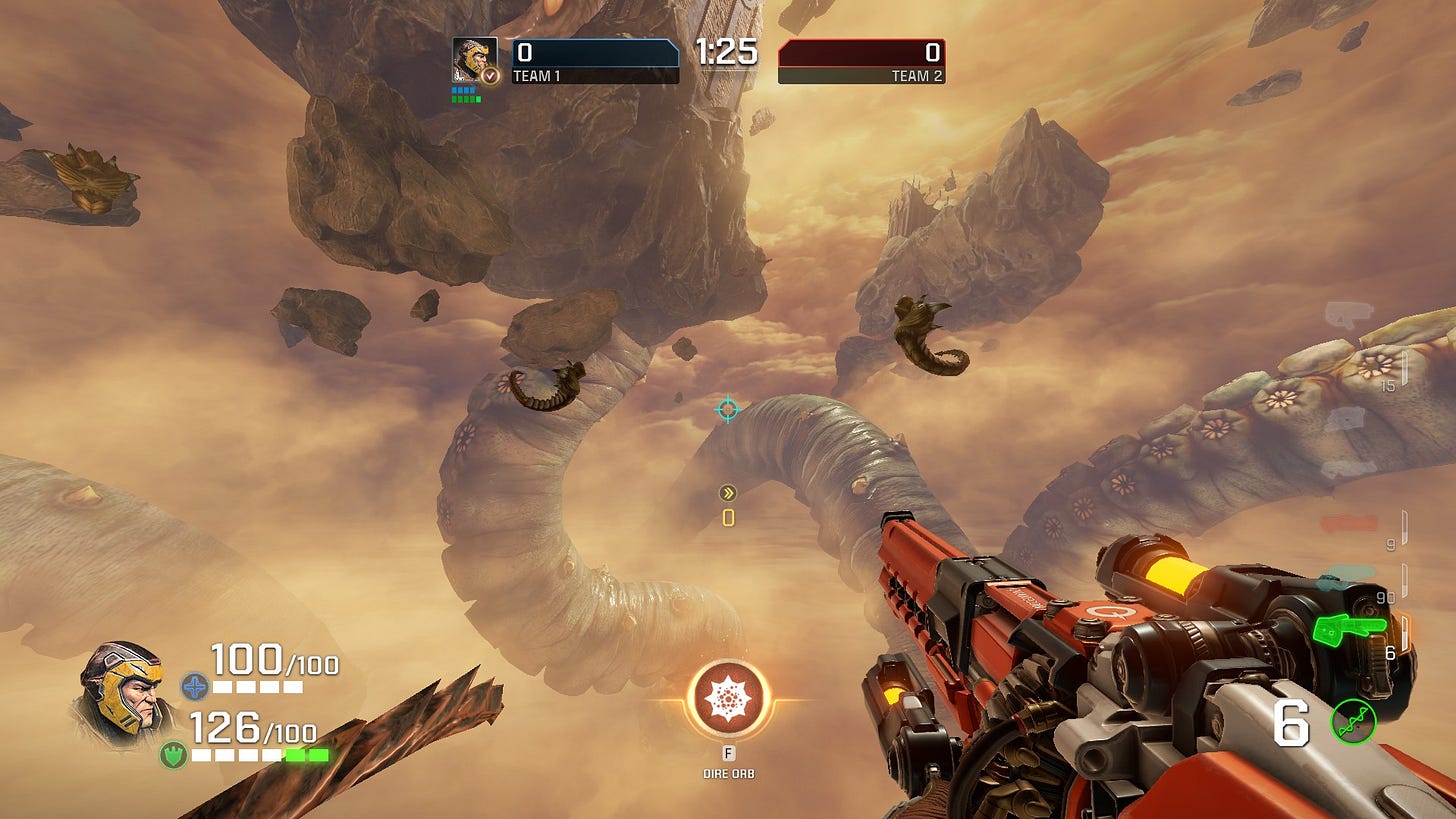
Single-player is also an excellent way for new players to get accustomed to the game’s movement and weapons. Unlike multiplayer, dying wouldn’t mean having to run around for all the weapons again if you want to practice with them, and even the hardest campaign wouldn’t torch you before you got a chance to fight back. For as fun as Quake’s formula can be in multiplayer, too, wielding its weapons and nimbly navigating around its enemies in single-player is its own kind of fun. I love the way Champions feels to play, but I’ve often lamented that the only way for me to experience that is by playing against a dwindling community of die-hards. Evidence like the design of the recent remaster expansions and Champions’ excellent map designs and lore show that id has every ingredient they could need to do single-player right, and it would be a part of the experience that shows people how awesome Quake is without any reliance on other, so often-disappointing players. Plus, with how much more experimental Doom’s campaigns have grown, Quake can be the played-straight boomer shooter it’s always been without id feeling like they’re cannibalizing themselves.
Of course, multiplayer is still going to be a big part of the game, and I wouldn’t have it any other way. For as much as I want a new Quake single-player in the style of the first game, the experience of that first game isn’t compromised by any fewer people playing it. Much of why I’d love for a new Quake to succeed is so that its multiplayer community can grow vibrant once again, but just how does id actually make that happen? Frankly, I don’t think it’s as difficult as it might seem. It doesn’t take any risky new gimmicks or a whole overhaul of the formula. All they really have to do is nail the basic gameplay and then make sure the surrounding experience is comprehensive. All manner of Quake fan should be able to play this game the way they like it best, because Quake truly is more than top-level duels on the same three maps.
Many complaints about the modern shooter landscape focus on the loss of many friendly features from the days of yore. Games no longer tend to have player-hosted servers, a wide variety of modes, or customizable rulesets; all things that ruled the day in Halo’s heyday, for instance. Quake finds itself with the unique opportunity to fill that niche in an increasingly homogenized market. By all means, include the classic modes like team deathmatch, clan arena, and duel and make great maps to play them on. Also, make sure to include some decent tutorials that introduce the way things like movement and map control work in Quake because it’s not intuitive. This is really the easy part, because it’s what Quake has most definitely already mastered. Even Champions, for all its mistakes, still felt like Quake should at its core. Those rules are great, but they aren’t the best for every mode or type of player. The game can’t stop there.
Quake is such a foundational formula that it can play around with all sorts of game types. Make big, open maps for large player counts; they may not be the best for competition, but they’d be a lot of fun for chaotic deathmatches or other creative modes. Experiment with a wide variety of objectives and playstyles to keep the experience exciting even for those who aren’t going to master the game. Casual modes could benefit from shorter cooldowns for things like the mega health, and even access to crazier weapons and power-ups than what would fly in more serious modes. Perhaps there could be a mode like Splatoon’s Rainmaker, where teams must carry a powerful weapon into the enemy base, but with a BFG! What’s more, the game could include server hosting and a high degree of customization for rulesets, making it easy for groups of friends to play with each other and tweak the game to their liking. The potential for fun is endless! They could even go a step further and include a map editor for community sharing in the true Quake tradition.
Of course, one has to compete in the current language of the marketplace. Quake shouldn’t struggle to fill a battlepass and store with good cosmetics, though. Just like Quake Champions, it could resurrect the classic Quake weapon models, like the timeless original lightning gun and rocket launcher, as cosmetics to buy. The countless characters from every game, including almost all of Quake III: Arena and Quake Champions’ characters, could easily be player skins that all generally map well onto the same hitboxes. Just like in Quake III, the game could have a whole host of emotes that could even be performed while moving. As long as the devs can keep things exciting - an easy thing when you can include the Doom Slayer in your game without some kind of complicated licensing deal - it would not be hard to fit this game into a free-to-play cosmetic model. Like Halo Infinite, it could even make its multiplayer free while charging for the campaign, and it could even justify a lower price for the campaign thanks to the amount of money cosmetic charges tend to make for games these days.
All in all, I think it’s silly to think of Quake as a hopeless franchise. The audience is out there; all id (or MachineGames, or whoever else at Bethesda wants to take a stab at it) has to do is make a Quake by the book and be smart about it. Beyond all of the challenges it faces, from an increasingly insular base of competitive purists to a bad-luck series of PR flops, Quake has to its name something so few franchises can claim: strong design fundamentals and genuine inspiration. By now, you know Quake’s history has been all about surviving through hardship. It started out as something it wasn’t supposed to be, and became something even better. Despite failures and constant shifts in focus, it still carved an identity out for itself. It’s not beautiful in spite of the bizarre; it’s beautiful because of it. Quake is owed much better than this, and I’m not alone in saying that. If you pay attention, you’ll feel this franchise’s will to exist beating like a drum beneath the industry. It calls to us. We call to it. And goddamnit, Nightdive is saying their “next big thing” is getting revealed at QuakeCon this August. A man can dream.


